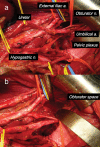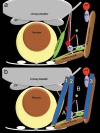Is There Any Reason to Still Consider Lateral Lymph Node Dissection in Rectal Cancer? Rationale and Technique
- PMID: 29184470
- PMCID: PMC5703666
- DOI: 10.1055/s-0037-1606112
Is There Any Reason to Still Consider Lateral Lymph Node Dissection in Rectal Cancer? Rationale and Technique
Abstract
Nodal dissemination in locally advanced rectal cancer occurs mainly in two directions: upward and lateral. Lateral node involvement has been demonstrated; however, lateral lymph node dissection (LLND) is not routinely performed in Western countries and the focus is more on neoadjuvant treatment regimens. The main reasons for this are the high morbidity associated with the operation and the uncertain oncological benefit. There is, however, recent evidence that in selected cases, neoadjuvant treatment combined with total mesorectal excision only might not be sufficient. In this article, the historical developments in the East and the West, the current evidence regarding lateral nodal disease, and the surgical steps in the LLND are discussed.
Keywords: lateral nodes; local recurrence; rectal cancer.
Conflict of interest statement
Figures





References
-
- Gerota D. Die lymphgefasse des rectums und des anus. Arch Anat Physiol. 1895;181:240.
-
- Miles W E. A method of performing abdomino-perineal excision for carcinoma of the rectum and of the terminal portion of the pelvic colon. Lancet. 1908;2:1812–1813. - PubMed
-
- Sunderland D A. The significance of vein invasion by cancer of the rectum and sigmoid; a microscopic study of 210 cases. Cancer. 1949;2(03):429–437. - PubMed
-
- Wangensteen O H, Toon R W. Primary resection of the colon and rectum with particular reference to cancer and ulcerative colitis. Am J Surg. 1948;75(02):384–404. - PubMed
Publication types
LinkOut - more resources
Full Text Sources
Other Literature Sources

